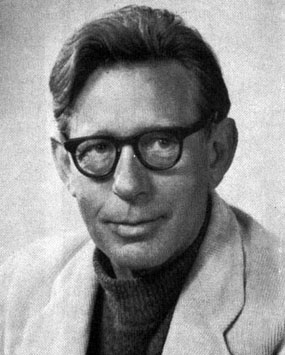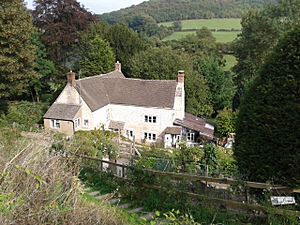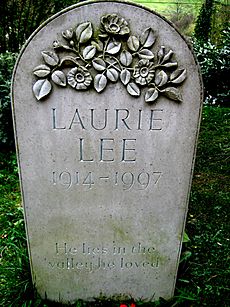Laurie Lee facts for kids
Quick facts for kids
Laurie Lee
|
|
|---|---|
 |
|
| Born | Laurence Edward Alan Lee 26 June 1914 Stroud, Gloucestershire, England |
| Died | 13 May 1997 (aged 82) Slad, Gloucestershire, England |
| Resting place | Slad churchyard |
| Occupation | Author, screenwriter, poet |
| Language | English |
| Years active | 1934–1997 |
| Notable works | Cider with Rosie As I Walked Out One Midsummer Morning A Moment of War |
| Notable awards | Member of the Most Excellent Order of the British Empire |
| Spouse | Katherine Francesca Lee |
| Children | 2 |
| Relatives | Jack Lee (brother) |
Laurence Edward Alan Lee, often known as Laurie Lee, was an English poet, novelist, and screenwriter. He was born on June 26, 1914, and passed away on May 13, 1997. Laurie Lee grew up in the quiet village of Slad in Gloucestershire, England.
He is most famous for his three autobiographical books, which tell the story of his own life. These are Cider with Rosie (1959), As I Walked Out One Midsummer Morning (1969), and A Moment of War (1991). The first book describes his childhood in the beautiful Slad Valley. The second book shares his adventures when he left home for London and first visited Spain in 1935. The third book tells about his return to Spain in 1937 to help fight in the Spanish Civil War.
Contents
Growing Up in Slad
Laurie Lee was born in Stroud, Gloucestershire, in 1914. When he was three years old, his family moved to the village of Slad. This move is how his famous book Cider with Rosie begins. His father, Reginald Joseph Lee, fought in the First World War and did not return home after the war. Laurie and his many brothers and sisters were raised by their mother, Annie Emily Light. His brother Jack Lee later became a film director.
When Laurie was 12, he went to the Central Boys' School in Stroud. By the time he was 14, he was quite good at playing the violin and was often asked to play at dances.
Early Jobs and Travels
Laurie Lee left school at 15 and worked as an errand boy for an accounting firm. He also worked as an office clerk and a builder's labourer. In 1931, he discovered the Whiteway Colony, a community near Slad founded by people with special ideas about how society should work. This was his first introduction to politics.
At 20, Laurie Lee moved to London for a year. In the summer of 1935, he decided to travel to Vigo, in northwest Spain. From there, he walked across Spain, often playing his violin to earn money. His first trip to Spain is the main topic of As I Walked Out One Midsummer Morning.
Joining the Spanish Civil War
The Spanish Civil War began in July 1936. Laurie Lee was in southern Spain when it started and was picked up by a British ship, HMS Blanche, which was rescuing British citizens.
In 1937, Lee returned to Spain to join the International Brigades. These were groups of volunteers from different countries who came to help one side in the war. However, his time fighting was cut short because he had epilepsy. His experiences during this time are told in his book A Moment of War. After his death, some people questioned how much he was involved in the war, but his wife said these claims were "ludicrous" (meaning ridiculous).
Life as a Writer
Before 1951, Laurie Lee mostly worked as a journalist and wrote scripts. During the Second World War, he made documentary films for government film units. From 1944 to 1946, he worked as an editor for the Ministry of Information. In 1950, he married Catherine Francesca Polge, and they had a daughter named Jessie. In 1952, he received a special award called the Member of the Order of the British Empire for his work on the Festival of Britain.
His autobiographical novel Cider with Rosie became very popular in 1959. Its success allowed him to become a full-time writer. This book is still one of the most loved books in the UK and is often studied by schoolchildren. It paints a clear picture of what rural life was like when Lee was young, showing both the challenges and the simple joys. Lee said it took him two years to write the book, and he wrote it three times! With the money he earned, he was able to buy a cottage in Slad, the village he loved so much.
His Poetry
Poetry was Laurie Lee's first passion, even though he was more famous for his prose. His poems appeared in local newspapers and national magazines. His first collection of poems, The Sun My Monument, was published in 1944. He followed this with The Bloom of Candles (1947) and My Many-coated Man (1955). Many of his poems from the 1940s capture the feeling of wartime but also the beauty of the English countryside.
Other Books and Works
Besides his famous trilogy, Laurie Lee wrote other books. A Rose for Winter is about a trip he took to Andalusia, Spain, years after the civil war. Two Women (1983) tells the story of his courtship and marriage to Kathy. The Firstborn (1964) is about the birth and childhood of his daughter, Jessy. I Can't Stay Long (1975) is a collection of his shorter writings.
Lee also wrote travel books, essays, radio plays, and short stories. He even wrote for British Transport Films, including 'Journey into Spring'.
Awards and Recognition
Laurie Lee received several awards for his writing. These included the Atlantic Award (1944), the Society of Authors travelling award (1951), the William Foyle Poetry Prize (1956), and the W. H. Smith and Son Award (1960).
In his book As I Walked Out One Midsummer Morning, Lee wrote about a Spanish fishing village he called "Castillo." In 1988, the people of Almuñécar, a real Spanish town, put up a statue to honor him.
In 1993, his book A Moment of War was chosen as a "Notable Book of the Year" by the editors of the New York Times Book Review.
Lee also supported a group of artists called the Brotherhood of Ruralists, and he is even said to have given them their name.
In 2003, the British Library bought Laurie Lee's original writings, letters, and diaries. This collection includes some plays that were not known before and early drafts of Cider with Rosie. These drafts show that he considered other titles for the book, like Cider with Poppy and Cider with Daisy.
Later Life and Legacy
In the 1960s, Laurie Lee and his wife moved back to Slad, the village where he grew up. He lived there for the rest of his life, though he also kept a flat in London for work during the week. He once joked on a TV show that children studying Cider with Rosie for school would often ask him "where Laurie Lee was buried," thinking he was already dead!
After he passed away, an old recording of Laurie Lee's voice was used to narrate the Carlton Television film Cider with Rosie (1998).
Laurie Lee died at his home in Slad on May 13, 1997, at the age of 82. He is buried in the local churchyard, in the valley he loved so much.
His Published Works
Books
- Land at War (1945)
- We Made a Film in Cyprus (1947), with Ralph Keene
- An Obstinate Exile (1951)
- A Rose for Winter: Travels in Andalusia (1955)
- Man Must Move: The Story of Transport (with David Lambert, 1960) – a book for children
- The Firstborn (1964)
- I Can't Stay Long (1975)
- Innocence in the Mirror (1978)
- Two Women (1983)
Autobiographical Trilogy
- Cider with Rosie (1959)
- As I Walked Out One Midsummer Morning (1969)
- A Moment of War (1991)
Poetry Collections
- The Sun My Monument (1944)
- The Bloom of Candles: Verse from a Poet's Year (1947)
- My Many-Coated Man (1955)
- The Pocket Poets Laurie Lee (1960)
- Selected Poems (1983)
Recordings
- Laurie Lee reading 'Cider with Rosie' complete and unabridged. ISIS audio books 1988.
- Laurie Lee Reading His Own Poems (1960), Decca music
Plays and Screenplays
- Peasants' Priest (1947), performed at the Canterbury Festival.
Screenplays for Films
- Cyprus Is an Island (1946)
- A Tale in a Teacup (1947)
Radio Plays
- The Voyage of Magellan (1946)
- Black Saturday, Red Sunday (1956)
- I Call Me Adam (1959)
Images for kids
See also
 In Spanish: Laurie Lee para niños
In Spanish: Laurie Lee para niños






